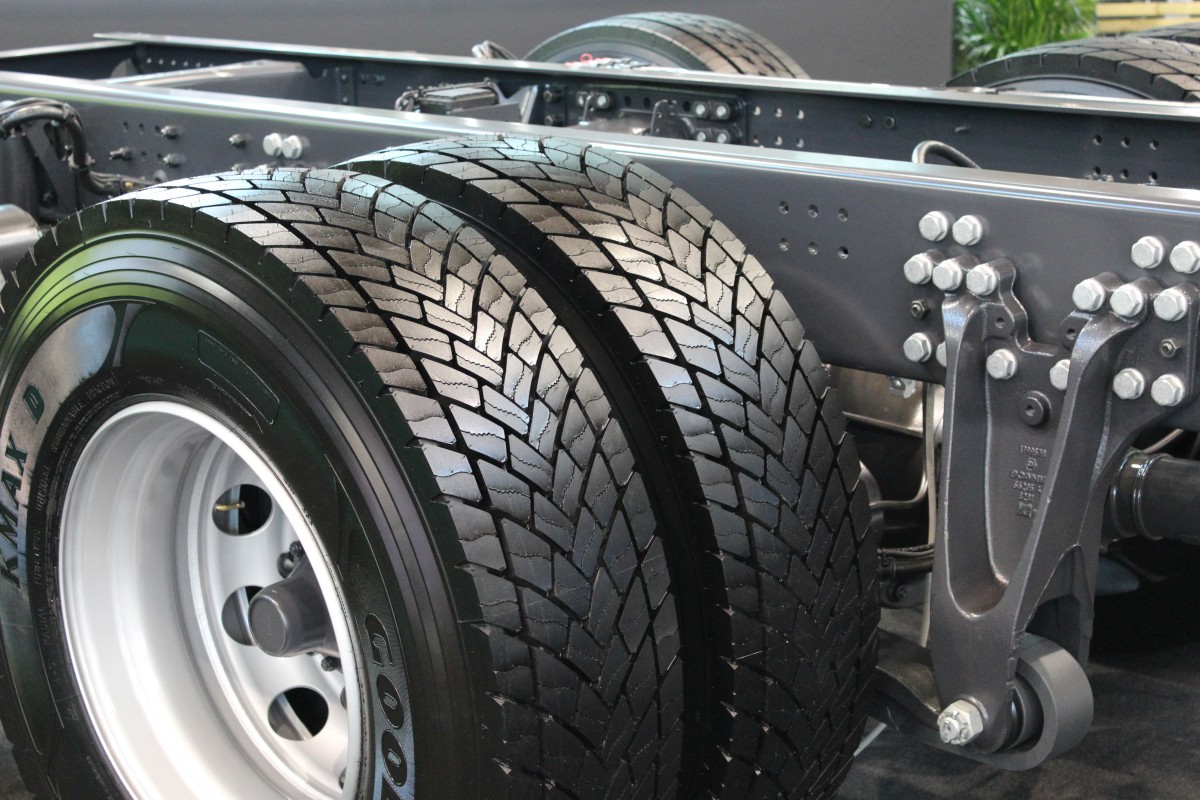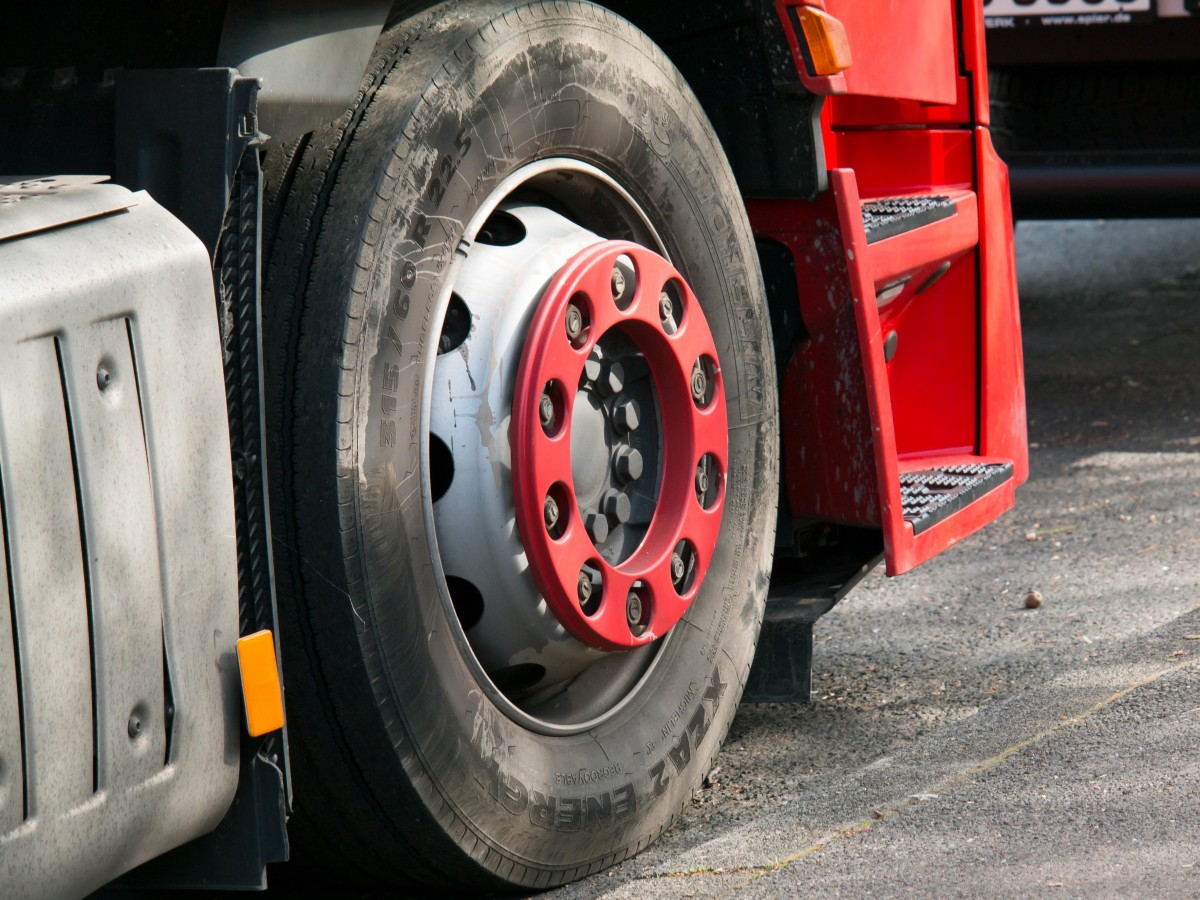Content:
– Truck tyres: specific features and importance of rolling resistance
– Trucks: tyres adapted to each axle
– Truck tyre: marking and indices
Truck tyre: specific features and importance of rolling resistance
A truck tyre is a component with extreme performance for professional use. The truck tyre is mainly tubeless and radial ply, using the same technologies as those used for passenger tyres.
Suitable for vehicles with a GVW (Gross Vehicle Weight Rating) of more than 3.5 tonnes, a truck tyre is larger and must in particular offer robustness, endurance and fuel-saving capacity.
With each revolution of the wheel, the tyre deforms on contact with the road and dissipates energy in the form of heat. This force is called rolling resistance and is responsible for 20% of the forces that naturally brake a car (the other forces being aerodynamic friction, mechanical friction, etc.).
On a truck, this rolling resistance is responsible for about 33% of the energy dissipated. In other words, one out of every three fill-ups of petrol is dissipated via the tyres, hence the need to focus on “green” technologies to reduce these effects.
Trucks: tyres adapted to each axle
In contrast to passenger car tyres, truck tyres cannot be fitted on all axles and a model is specific to a particular position on the vehicle:
– The steering axle is the front axle, directly involved in the orientation of the vehicle.
– The drive axle is the rear axle of a truck that is linked to the engine and transmits acceleration. The wheels are generally twinned on this axle, which therefore has four wheels, except in the case of adapted tyre models that allow two tyres to be replaced by a wider tyre.
– Carrying axles are trailer axles that follow the direction and traction imposed by the towing truck.
A model designed for one axle cannot be fitted to another axle. There are, however, all-position models that can be positioned in any position, but they are clearly defined as such by the manufacturers.
Truck tyre: marking and indices

The marking of the truck tyre is the same as for the passenger car tyre, i.e.:
– 335 = section = width of the tyre in millimetres (mm).
– 55 = series = ratio (in %) between the height of the tyre and the section (width). It is therefore a figure that gives an idea of the height of the sidewall, in other words, the “thickness” of the tyre.
– R is the radial structure of the tyre.
– 22.5 = inside diameter = rim diameter in inches (“).
– 91: load index corresponding to the maximum load in kg that the tyre can support.
– V: speed index corresponding to the maximum speed at which the tyre can be driven while maintaining the range of its performance.
The following table illustrates the figures corresponding to each speed code.
SPEED CODES
|
Speed code |
Speed in km/h |
|---|---|
|
A1 |
5 |
|
A2 |
10 |
|
A3 |
15 |
|
A4 |
20 |
|
A5 |
25 |
|
A6 |
30 |
|
A7 |
35 |
|
A8 |
40 |
|
B |
50 |
|
C |
60 |
|
D |
65 |
|
E |
70 |
|
F |
80 |
|
G |
90 |
|
J |
100 |
|
K |
110 |
|
L |
120 |
|
M |
130 |
|
N |
140 |
The following table illustrates the figures corresponding to each load index.
LOAD INDICES
|
Index |
Load kg |
Index |
Load kg |
Index |
Load kg |
Index |
Load kg |
|---|---|---|---|---|---|---|---|
|
100 |
800 |
123 |
1 550 |
146 |
3 000 |
169 |
5 800 |
|
101 |
825 |
124 |
1 600 |
147 |
3 075 |
170 |
6 000 |
|
102 |
850 |
125 |
1 650 |
148 |
3 150 |
171 |
6 150 |
|
103 |
875 |
126 |
1 700 |
149 |
3 250 |
172 |
6 300 |
|
104 |
900 |
127 |
1 750 |
150 |
3 350 |
173 |
6 500 |
|
105 |
925 |
128 |
1 800 |
151 |
3 450 |
174 |
6 700 |
|
106 |
950 |
129 |
1 850 |
152 |
3 550 |
175 |
6 900 |
|
107 |
975 |
130 |
1 900 |
153 |
3 650 |
176 |
7 100 |
|
108 |
1 000 |
131 |
1 950 |
154 |
3 750 |
177 |
7 300 |
|
109 |
1 030 |
132 |
2 000 |
155 |
3 875 |
178 |
7 500 |
|
110 |
1 060 |
133 |
2 060 |
156 |
4 000 |
179 |
7 750 |
|
111 |
1 090 |
134 |
2 120 |
157 |
4 125 |
180 |
8 000 |
|
112 |
1 120 |
135 |
2 180 |
158 |
4 250 |
181 |
8 250 |
|
113 |
1 150 |
136 |
2 240 |
159 |
4 375 |
182 |
8 500 |
|
114 |
1 180 |
137 |
2 300 |
160 |
4 500 |
183 |
8 750 |
|
115 |
1 215 |
138 |
2 360 |
161 |
4 625 |
184 |
9 000 |
|
116 |
1 250 |
139 |
2 430 |
162 |
4 750 |
185 |
9 250 |
|
117 |
1 285 |
140 |
2 500 |
163 |
4 875 |
186 |
9 500 |
|
118 |
1 320 |
141 |
2 575 |
164 |
5 000 |
187 |
9 750 |
|
119 |
1 360 |
142 |
2 650 |
165 |
5 150 |
188 |
10 000 |
|
120 |
1 400 |
143 |
2 725 |
166 |
5 300 |
189 |
10 300 |
|
121 |
1 450 |
144 |
2 800 |
167 |
5 450 |
190 |
10 600 |
|
122 |
1 500 |
145 |
2 900 |
168 |
5 600 |
191 |
10 900 |
If you are looking for a tyre shop, second-hand truck tyres, new truck tyres or even cheap truck tyres, you can visit GILL VIC TYRES in the Dandenong area.
Coming soon, our next section will cover:
– Regrooving: a second life given to the truck tyre;
– Retreading: a third life given to the truck tyre;
– A variety of uses for this type of tyre;
– Truck tyre legislation.
Follow us on Cars and Motors Online and don’t forget to leave your comments and also share your experience with our readers. See you next time!


1 comment
[…] – How to Read Truck Tyres […]